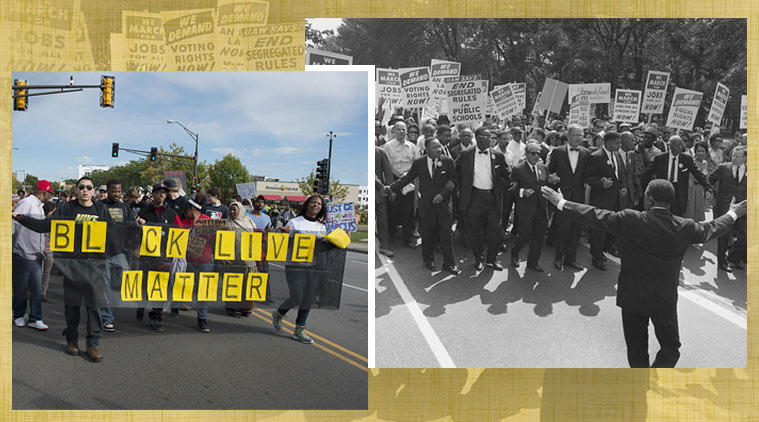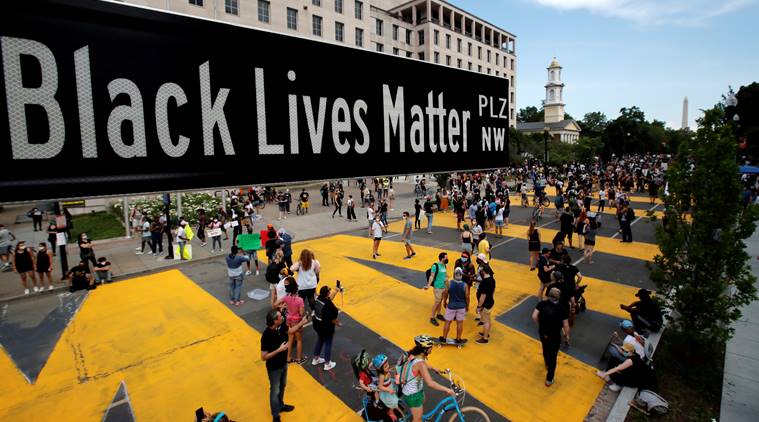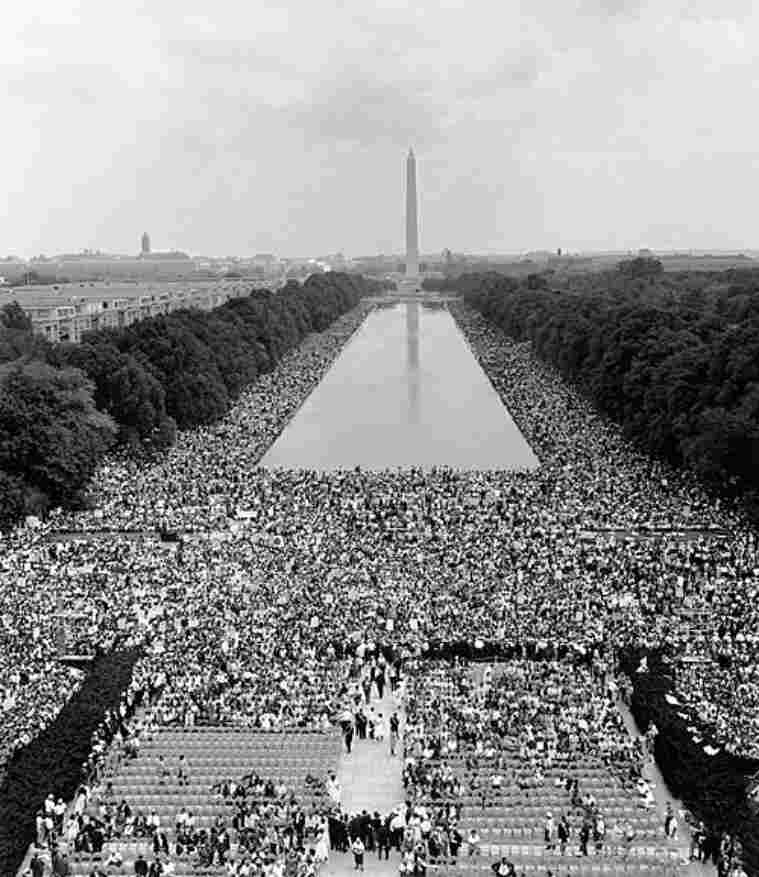- India
- International
Seven years of #BlackLivesMatter: Culmination of over a century of protests
The Black Lives Matter movement, which completes seven years this July, needs to be understood as the continuation of a long journey of fervent struggles that the Black community has undertaken in the USA.
 Black Lives Matter movement is a culmination of Black movements in America that can be traced back to the beginning of the 20th century, when discrimination and violence against African-Americans had led to several vivacious movements in the country. (Source: Wikimedia Commons)
Black Lives Matter movement is a culmination of Black movements in America that can be traced back to the beginning of the 20th century, when discrimination and violence against African-Americans had led to several vivacious movements in the country. (Source: Wikimedia Commons)
On the evening of February 26, 2012, a 17-year-old Trayvon Martin was walking through a neighbourhood in Sanford, Florida, with a soft drink in his hand. Though unarmed, the colour of the African-American’s skin quickly caught the attention of George Zimmerman, a neighbourhood watch volunteer. Being suspicious of the teen, Zimmerman called the police. Though they asked him to maintain distance, he soon got into a confrontation with Martin, which ended in the Black teenager being shot dead. A year later, in the summer of 2013, the verdict on the case was declared: “Not guilty of second-degree murder and acquitted of manslaughter.”
At Oakland in California, Alicia Garza, a civil rights activist had been following Zimmerman’s trial closely. In an emotional outburst, following the verdict, she took to Facebook to pen down her thoughts: “Black people. I love you. I love us. Our lives matter. Black Lives Matter.” Her post caught the attention of Patrisse Cullors who added the hashtag #blacklivesmatter. Garza and Cullors was joined by New York City-based immigration organiser Opal Tometi, who on July 13, 2013, gave birth to the movement that is often referred to as the modern era’s civil rights movement.
 A street sign of Black Lives Matter Plaza is seen near St. John’s Episcopal Church, as the protests against the death in Minneapolis police custody of George Floyd continue, in Washington. (Source: Reuters)
A street sign of Black Lives Matter Plaza is seen near St. John’s Episcopal Church, as the protests against the death in Minneapolis police custody of George Floyd continue, in Washington. (Source: Reuters)
For the last seven years, ‘Black Lives Matter’ has been the clarion call that demands change in America. Over time, it has been the face of protests against racism across the globe. “From quarterbacks to hashtags, from mall demonstrations to community vigils, and from the streets of New York to the courts of Texas, the Black Lives Matter movement undisputedly has made its mark on America consciousness,” writes lawyer Garrette Chase in his research paper, ‘The early history of the Black Lives Matter movement and the implications thereof’.
In context of the recent protests against the brutal assault and murder of George Floyd, the movement has spread out with renewed spirit across Europe, Australia, Asia, and South America. As philosopher Christopher J. Lebron puts it in his book, ‘The making of Black Lives Matter: A brief history of an idea’, “#BlackLivesMatter represents an ideal that motivates, mobilises, and informs the actions and programs of many local branches of the movement.”
Yet it would be safe to say that Black Lives Matter movement is a culmination of Black movements in America that can be traced back to the beginning of the 20th century, when discrimination and violence against African-Americans had led to several vivacious movements in the country that had far-reaching legal and socio-political implications.
Timeline- A short history of Black movements in America

While slavery had ended in America in 1865, discrimination against Blacks took various other forms — the Jim Crow laws that made segregated spaces and institutions for Blacks and whites, the formation of Ku Kux Klan that attacked Blacks in its attempt to promote white supremacy, and race riots.
One of the earliest responses to racial discrimination in the USA was the National Association for the Advancement of Colored People (NAACP), a civil rights organisation formed in 1909 to promote political, social, educational, and economic equality between Blacks and whites.
In the 1920s, the Harlem renaissance emerged as an intellectual and artistic movement that celebrated African-American culture and history. It is believed to have been the rebirth of African-American arts.
But it was really the 1950s and 60s that the movement for racial equality reached its zenith.It all began on December 1, 1955, when 42-year-old Rosa Parks found a seat on a Montgomery, Alabama bus. Segregation laws which were in operation at that time made it compulsory for Blacks and whites to be seated on designated seats. When a white man confronted Parks, asking her to vacate her seat, she refused and was arrested.
Her arrest sparked outrage and support came in the form of the Montgomery Improvement Association (MIA) led by the Baptist minister Martin Luther King Jr., who would eventually be at the forefront of the civil rights movement in America. The MIA staged a 381-day boycott against the Montgomery bus system, which eventually resulted in the Supreme Court ruling against segregated seating.
In the course of the next decade, the movement would take several forms and mark many important achievements for Black rights. The assassination of King on April 4, 1968, would mark the end of the movement.
 The March on Washington in 1963, where King delivered his famous ‘I have a dream’ speech. (Source: Wikimedia Commons)
The March on Washington in 1963, where King delivered his famous ‘I have a dream’ speech. (Source: Wikimedia Commons)
After 1968, however, the movement for Black rights shifted its form. “As African Americans gained new access to white-dominated institutions, the freedom struggle moved inside from the streets,” writes American historian Nancy MacLean in her article, ‘The Civil Rights Movement:1968—2008’.
This new phase saw Black students fighting for African-American study programmes in colleges, financial aid for those from the impoverished background, affirmative actions in military and equitable employment opportunities in almost every other professional field. “The new stage of struggle also saw more active coalition-building with other groups affected by discrimination and inequality,” writes MacLead adding that “after 1968, Blacks and Latinos and Asian Americans sometimes joined together in campaigns for substantive equal treatment and better life chances.”
Also read: Explained: Why a capital ‘B’ in ‘Black’ is culmination of very long journey
In March, 1991, Rodney King, a Black motorist was beaten up by four LAPD officers after a high speed chase. The incident, which was video-taped sparked massive outrage, leading to one of the worst race riots in Los Angeles. After the four officers were acquitted in the trial, thousands came out on the streets. Looting and assault had followed, leaving over 50 dead and 2300 injured.
Fifteen years later, when Barack Obama won the presidential elections in November 2008, it was seen as a moment of victory and pride for the Black community in the United States. Yet, the execution of Troy Davis in 2011 showed that much was yet to be changed. Many believed that Davis was wrongfully convicted for the murder of a police officer. A day after his execution on September 21, 2011, hundreds came out on the streets of New York, and assembled at the Union Square in Manhattan. The protests against Troy Davis came to be merged with the Occupy Wall Street movement, showing how racism and Black poverty was connected.
The Black Lives Matter movement, which completes seven years this July, needs to be understood as the continuation of this long journey of fervent struggles that the Black community has undertaken in the USA.
Further reading
The early history of the Black Lives Matter movement and the implications thereof, by Garrett Chase
The Making of Black Lives Matter: A Brief History of an Idea, by Christopher J. Lebron
The Civil Rights Movement: 1968—2008, by Nancy MacLean
Best of Express
Buzzing Now
Apr 18: Latest News
- 01
- 02
- 03
- 04
- 05






































